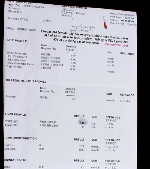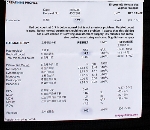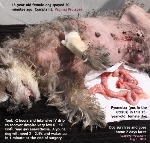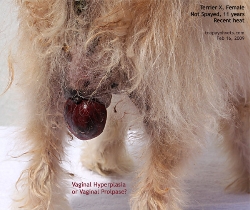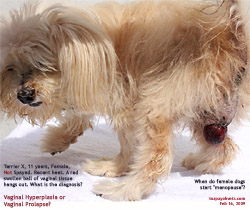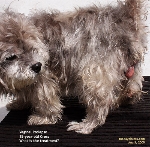 Logically, one combined surgery
to spay and remove the breast
tumours under one anaesthesia
would be economical for the dog
owner and good for the dog as
she does not need to have
another operation.
Logically, one combined surgery
to spay and remove the breast
tumours under one anaesthesia
would be economical for the dog
owner and good for the dog as
she does not need to have
another operation. That was what my assistant said to me. "Well, people are not so kind when the dog dies on the operating table when the vet does what is logical and the dog dies. They will just bad-mouth about the vet's incompetence to anyone who comes into contact with them. You have heard such remarks recently."
"A short surgery means a short duration of anaesthesia," I explained to the man who was very keen on veterinary medicine and surgery. "It is less risky for the old dog. I mean she is 15 years old. She would be equivalent to a 105-year-old woman now."
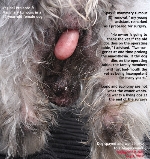 Surprisingly she still had the
estrus cycle as vaginal prolapse
is associated with the onset of
the heat cycle. The owner agreed
to a blood test which showed
slight increase in liver
enzymes. This dog was quite
healthy and had a 60% chance of
survival under a short
anaesthesia and surgery. From my
experience, the surgery should
be completed in less than 15
minutes. The owner had to
decide. She gave the go-ahead
for the spay and teeth scaling
and dental work.
Surprisingly she still had the
estrus cycle as vaginal prolapse
is associated with the onset of
the heat cycle. The owner agreed
to a blood test which showed
slight increase in liver
enzymes. This dog was quite
healthy and had a 60% chance of
survival under a short
anaesthesia and surgery. From my
experience, the surgery should
be completed in less than 15
minutes. The owner had to
decide. She gave the go-ahead
for the spay and teeth scaling
and dental work. The spay was completed in 15 minutes. Total time taken was 25 minutes of anaesthesia using isoflurane gas at 1-2% and intubation as the dog took some time to be given gas mask. Excellent anaesthesia. Before stitching, I had the gas switched off to 0%. The blood colour was excellent and bright red. However, the dog did not wake up as what other younger and normal dogs would do under such low anaesthesia. He took about 10 minutes to wake up and was very sleepy. 5% glucose IV drip was given during surgery and then a bottle of dextrose saline overnight. The dog was OK and the lady owner was happy.
Teamwork
is important in old dog
anaesthesia. My first assistant,
Mr Saw monitored the anaesthesia
like a hawk. My second assistant
who had thought that this case
should be 2 surgeries in one
(spay and breast tumour removal)
helped me in the surgery and
that is the secret to a shorter
15-minute spay. Normally, I
don't give myself unnecessary
stress and a normal dog spay
takes around 30 minutes.
It was great to see the old
female dog alive. As for the
breast tumour, it may be best
not to operate. The spay showed
that the uterine tissues had
gone cystic - as in a closed
pyometra case. The dog should
not have any more vaginal
prolapse as she would not by
having heat. Do such old dogs
still have estrous cycle?
Apparently so in this case. Spay
is the treatment to prevent any
more recurrence of vaginal
prolapse in female dogs and this
is why I did the spay first. The
complaint from the owner was
vaginal prolapse and not breast
tumour. Therefore, know what the
client wants and don't get
side-tracked. The dog did get
her teeth scaled and four rotten
teeth extracted under one
anaesthesia but this did not
take more than 10 minutes. She
should have a better quality of
life now, with a tartar-free
clean mouth and not having to
lick her protruding vaginal
prolapsed mass.
 TOA
PAYOH VETS
TOA
PAYOH VETS